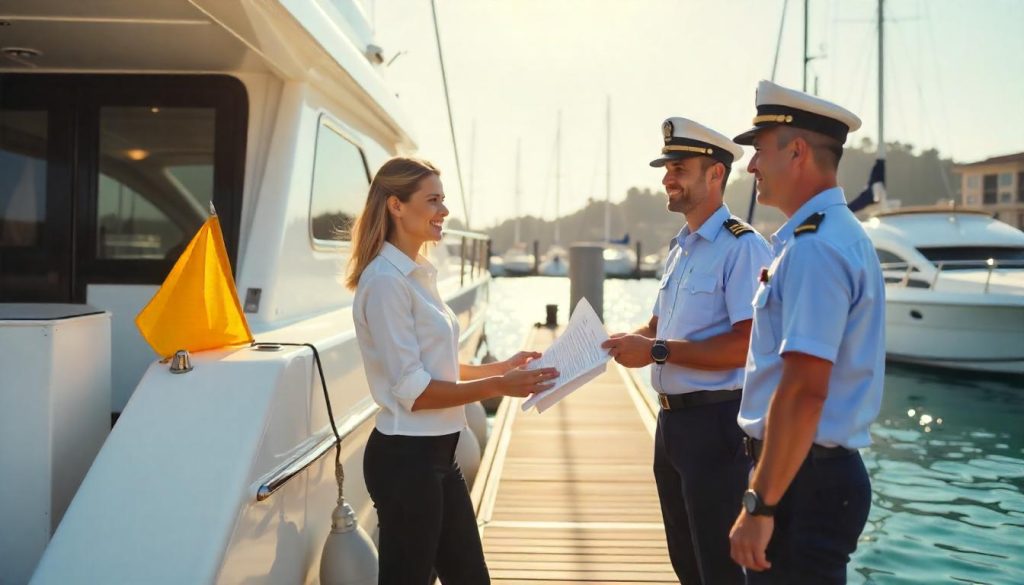Embarking on an international voyage by boat offers unparalleled freedom and adventure. Imagine cruising through azure waters, discovering hidden coves, and exploring vibrant new cultures. However, crossing international borders by sea requires meticulous preparation. Successfully navigating boat customs immigration procedures ensures a smooth, stress-free journey. Conversely, overlooking key requirements can lead to significant delays, fines, or even denial of entry. For anyone dreaming of such an expedition, perhaps from a landlocked location like Aktobe, understanding these protocols is paramount. This guide provides comprehensive steps to prepare for and execute international maritime clearances with confidence.
Pre-Voyage Essentials: Documentation & Planning
Effective preparation begins long before your vessel leaves its home port. Gathering and organizing all necessary documentation is the first, most crucial step for a hassle-free experience.
Vessel Documentation: What Your Boat Needs
First and foremost, confirm all your boat’s papers are current and in perfect order. Your vessel registration is vital. It proves ownership and the boat’s nationality. This document must remain valid for the entirety of your trip. Also, consider obtaining an International Certificate of Competence (ICC) if your home country issues one. This widely recognized credential serves as proof of your boating qualifications.
Furthermore, your boat needs a Ship’s Radio License for its communication equipment. Most countries mandate valid marine insurance. Therefore, always carry undeniable proof of comprehensive liability coverage. Some nations might even require a specific minimum sum insured. Proof of VAT paid (if applicable, especially for EU countries) is equally crucial. Keep original invoices or a “VAT deemed paid” certificate readily accessible onboard. Finally, if you are not the registered owner, carry a notarized letter of authorization from the owner. This grants you permission to operate the vessel internationally.
Crew and Passenger Papers: Personal Requirements
Every person aboard your vessel must possess valid travel documents. A current passport is essential for international travel. Ensure it remains valid for at least six months beyond your anticipated return date. Next, research visa requirements thoroughly for all countries on your itinerary. Include any potential transit stops. Some countries offer visas upon arrival. Others, however, demand advance applications, a process that can take weeks or even months. Plan accordingly.
It is also prudent to carry comprehensive health insurance that covers international travel. Bring your insurance cards and full policy details. Maintain a detailed crew list at all times. This document should include full names, nationalities, passport numbers, dates of birth, and each person’s role on the vessel. Consequently, this document is frequently requested by border authorities.
Route Planning: Ports of Entry & Notifications
Before setting sail, meticulously plot your course. Identify designated ports of entry in each country you intend to visit. It is often a legal requirement to proceed directly to the first available port of entry upon entering a country’s territorial waters. Avoid stopping or dropping anchor elsewhere until you have officially cleared customs and immigration.
Moreover, inquire about pre-arrival notification requirements. Many countries, including the United States with its CBP ROAM app, prefer or even require electronic notification before your arrival. This can significantly expedite the clearance process. Some nations may also demand a specific “zarpe” or exit document from your previous port of call. Thoroughly research these specific details to prevent any avoidable delays or potential fines.
Approaching the Border: On-Water Protocols
As your vessel nears its international destination, specific maritime protocols must be diligently followed. These signals indicate your intent to clear customs and ensure compliance with local regulations.
Hoisting the Q-Flag: Signaling Arrival
Upon entering the territorial waters of a foreign country, you must hoist the “Q” (Quarantine) flag. This is a plain yellow flag. It clearly signals that your vessel is arriving from a foreign port and requires official clearance. Keep this flag flying prominently. Continue flying it until all customs, immigration, and health formalities are fully complete. After successful clearance, replace it with the host country’s courtesy flag. This flag should be flown from the starboard spreader. A clean, well-maintained courtesy flag shows great respect for the host nation.
Establishing Contact: Radio Communications
As you draw closer to your chosen port of entry, establish contact with local authorities. You might call the harbor master, port control, or directly contact customs and immigration officials. Use your VHF radio; Channels 16 or 09 are commonly used for this purpose. State your vessel name, registration, and last port of call. Clearly express your intention to clear customs. They will provide precise instructions regarding where to dock or anchor, and when to present yourself to officials. Always follow their guidance meticulously.
Maintaining Onboard Control: No Shore Leave Yet
Do not allow anyone to leave or board your vessel until customs and immigration officials have granted explicit clearance. Only the vessel’s master (captain) should go ashore initially. This individual should carry all necessary documents. No one else should disembark unless specifically instructed to do so by the authorities. Strict adherence to this rule is crucial. It prevents potential issues with sailing immigration rules.
Clearing In: The On-Shore Process
The actual clearance process can vary greatly. Its length and formality depend heavily on the specific country and port. Therefore, be prepared for a wide range of scenarios.
The Interview: What to Expect
Upon arrival at the designated customs facility, the vessel’s master typically presents the documents first. You will likely need to show passports, visas, the crew list, and all vessel papers. Officials will ask a series of questions. These may cover your voyage, your next destination, the purpose of your visit, and any goods, food, or firearms on board.
Be honest and direct in your responses. Provide only the information requested. Officials may also decide to conduct an inspection of your vessel. Be prepared to open lockers, hatches, and any other compartments. Maintain a polite and cooperative demeanor throughout the entire process. Furthermore, dress presentably. It demonstrates respect for the authorities, which can facilitate a smoother process.
Fees, Permits, and Declarations: Key Details
- Customs Fees: Many countries charge fees for entry, clearance, or cruising permits. Have local currency readily available. Credit card facilities might not be an option in some remote areas. Always request a receipt for any payments made. This provides a clear record.
- Cruising Permits: Various nations require a cruising permit for private vessels. This applies if you plan to stay in their waters for an extended period. These permits are typically issued upon initial clearance. They might be valid for a specific duration, perhaps 90 days or one year.
- Food and Provisions: Be aware of strict restrictions. Many countries prohibit bringing in certain food items. Examples include fresh produce, raw meat, or dairy products. Declare any provisions honestly. Failure to do so could result in significant fines or confiscation of goods. This is a common point of contention during maritime border control.

Special Considerations and Departing a Country
Beyond the standard entry procedures, certain items or situations require special attention. Furthermore, a proper exit process is just as important as entry.
Firearms and Restricted Items: Know the Rules
If you have firearms on board, you must declare them immediately upon arrival. Regulations for firearms vary widely between countries. Some nations may require them to be sealed and stored for the entire duration of your stay. Other items, such as certain medications or cultural artifacts, may also have restrictions. Always research specific import/export prohibitions for your chosen destination. This prevents legal complications.
Pets Onboard: Specific Requirements
Traveling with pets adds another layer of complexity to customs procedures for boats. Most countries have strict health regulations for animals. These often include specific vaccinations, microchipping, and health certificates from a veterinarian. Some nations may require a quarantine period upon arrival. Research these requirements well in advance. Begin the necessary veterinary preparations months before your trip.
Digital Reporting Systems: Streamlining Your Entry
O CBP ROAM app (Reporting Offsite Arrival – Mobile) is widely used for U.S. arrivals. This innovative application allows boaters to submit their information electronically. You can even conduct video calls for clearance, often eliminating the need for an in-person reporting office visit. Other countries may have similar digital platforms. While these systems streamline the process, remember that officials can still conduct in-person inspections at any time.
Clearing Out: The Exit Formalities
Just as you clear customs upon arrival, you will often need to clear out before departing a country. This usually involves reporting to customs and immigration officials again. You will obtain an exit zarpe or clearance document. This document verifies your legal departure from the country. Furthermore, it is often a mandatory requirement for entry into your next destination. Do not skip this vital step.
Staying Prepared: Best Practices for Boaters
Successful international boating requires ongoing vigilance and meticulous record-keeping. These practices will contribute to a smoother experience.
Organized Documents: Stay Prepared
Maintain a dedicated, waterproof document holder. This should contain all your vessel and crew papers. Keep original documents in a safe, secure location. However, have photocopies readily available for presentation. A boat stamp with your vessel’s name, registration, and homeport can also significantly expedite paperwork. This small detail often impresses officials.
Continuous Research: Regulations Change
Regulations can change frequently and without much warning. Therefore, before and throughout your trip, consult reliable resources. These include government travel advisories, reputable cruising guides, and online platforms specifically for international boaters (e.g., Noonsite.com). These resources often provide the most up-to-date information on entry requirements, fees, and local customs. Continuous research helps avoid surprises.
Professional Demeanor: Patience is Key
Customs and immigration procedures can sometimes be lengthy. This is especially true in remote areas or during peak travel periods. Remain patient, polite, and respectful of the authorities at all times. A positive attitude can go a long way. It often ensures a smooth and efficient clearance process. Remember, they are doing their job to protect their country’s borders.
By understanding these procedures and diligently preparing, you can navigate international borders by boat with confidence. Are you planning your first international voyage, or do you have a specific destination in mind for your next international boat clearance?

 How to Prepare for Customs and Immigration by Boat">
How to Prepare for Customs and Immigration by Boat">
